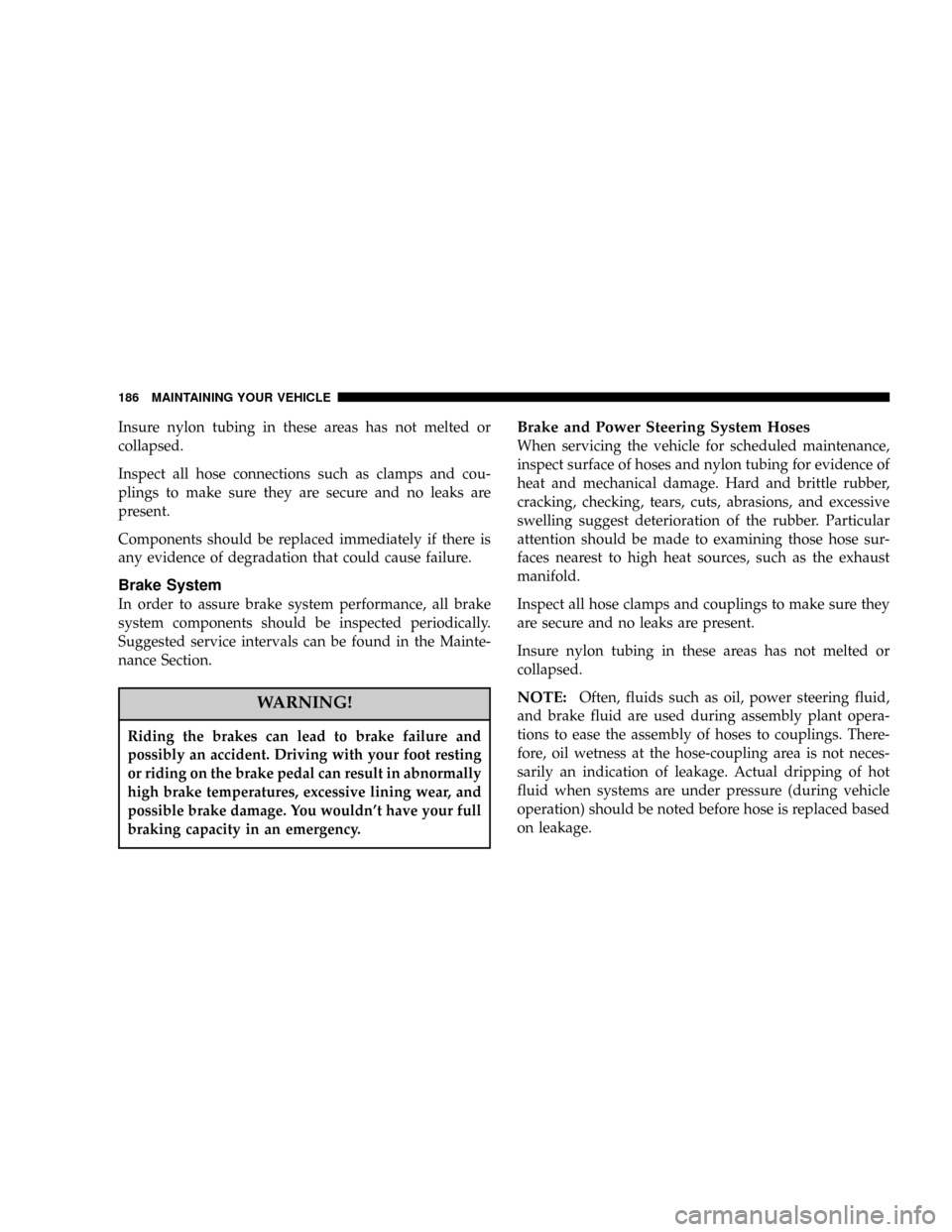2005 DODGE NEON oil temperature
[x] Cancel search: oil temperaturePage 151 of 246

the fan control to High. This allows the heater core to act
as a supplement to the radiator and aids in removing heat
from the engine cooling system.
CAUTION!
Driving with a hot cooling system could damage
your vehicle. If temperature gauge reads ªHº, pull
over and stop the vehicle. Idle the vehicle with the
air conditioner turned off until the pointer drops
back into the normal range. If the pointer remains on
the ªHº, turn the engine off immediately, and call for
service.
WARNING!
A hot engine cooling system is dangerous. You or
others could be badly burned by steam or boiling
coolant. You may want to call a service center if your
vehicle overheats. If you decide to look under the
hood yourself, see Section 7, Maintenance, of this
manual. Follow the warnings under the Cooling
System Pressure Cap paragraph.
WHAT TO DO IN EMERGENCIES 151
6
Page 170 of 246

Checking the oil while the vehicle is on level ground will
improve the accuracy of the oil level readings. Maintain
the oil level between the MIN and MAX markings on the
dipstick. Adding one quart of oil when the reading is at
the MIN mark will result in a MAX reading on these
engines.
CAUTION!
Overfilling or underfilling will cause aeration or
loss of oil pressure. This could damage your engine.
Change Engine Oil
Road conditions and your kind of driving affects the
interval at which your oil should be changed. Check the
following list to decide if any apply to you.
²Day and night temperatures are below 32ÉF (0ÉC)
²Stop and Go driving
²Extensive engine idling
Engine Oil Dipstick
170 MAINTAINING YOUR VEHICLE
Page 172 of 246

American Petroleum Institute (API) Engine Oil
Identification Symbol
This symbol means that the oil has
been certified by the American
Petroleum Institute (API). The
manufacturer only recommends
API Certified engine oils.
Engine Oil Viscosity (SAE Grade)
SAE 5W-20 engine oil is recommended for all operating
temperatures. This engine oil improves low tempera-
ture starting and vehicle fuel economy. Refer to your
engine oil filler cap for the recommended engine oil
viscosity for your vehicle.
For information on engine oil filler cap location, see the
Engine Compartment illustration in this section.
Lubricants which do not have both, the engine oil certi-
fication mark and the correct SAE viscosity grade num-
ber should not be used.
Synthetic Engine Oils
There are a number of engine oils being promoted as
either synthetic or semi-synthetic. If you chose to use
such a product, useonlythose oils that are American
Petroleum Institute (API) Certified and have the recom-
mended SAE viscosity grade. Follow the maintenance
schedule that describes your driving type.
Materials Added To Engine Oils
The manufacturer strongly recommends against the ad-
dition of any additives (other than leak detection dyes) to
the engine oil. Engine oil is an engineered product and
it's performance may be impaired by supplemental ad-
ditives.
Disposing of Used Engine Oil
Care should be taken in disposing of used engine oil from
your vehicle. Used oil, indiscriminately discarded, can
present a problem to the environment. Contact your
dealer, service station, or governmental agency for advice
on how and where used oil can be safely discarded in
your area.
172 MAINTAINING YOUR VEHICLE
Page 186 of 246

Insure nylon tubing in these areas has not melted or
collapsed.
Inspect all hose connections such as clamps and cou-
plings to make sure they are secure and no leaks are
present.
Components should be replaced immediately if there is
any evidence of degradation that could cause failure.
Brake System
In order to assure brake system performance, all brake
system components should be inspected periodically.
Suggested service intervals can be found in the Mainte-
nance Section.
WARNING!
Riding the brakes can lead to brake failure and
possibly an accident. Driving with your foot resting
or riding on the brake pedal can result in abnormally
high brake temperatures, excessive lining wear, and
possible brake damage. You wouldn't have your full
braking capacity in an emergency.
Brake and Power Steering System Hoses
When servicing the vehicle for scheduled maintenance,
inspect surface of hoses and nylon tubing for evidence of
heat and mechanical damage. Hard and brittle rubber,
cracking, checking, tears, cuts, abrasions, and excessive
swelling suggest deterioration of the rubber. Particular
attention should be made to examining those hose sur-
faces nearest to high heat sources, such as the exhaust
manifold.
Inspect all hose clamps and couplings to make sure they
are secure and no leaks are present.
Insure nylon tubing in these areas has not melted or
collapsed.
NOTE:Often, fluids such as oil, power steering fluid,
and brake fluid are used during assembly plant opera-
tions to ease the assembly of hoses to couplings. There-
fore, oil wetness at the hose-coupling area is not neces-
sarily an indication of leakage. Actual dripping of hot
fluid when systems are under pressure (during vehicle
operation) should be noted before hose is replaced based
on leakage.
186 MAINTAINING YOUR VEHICLE
Page 209 of 246

Schedule ªBº
Follow schedule ªBº if you usually operate your vehicle
under one or more of the following conditions.
Change the automatic transmission fluid and filter every
60,000 miles (96 000 km) if the vehicle is usually operated
under one or more of the conditions marked with anL.
Change the manual transaxle fluid every 48,000 miles (77
000 km) if the vehicle is usually operated under one or
more of the conditions marked with an ².
²Day or night temperatures are below 32ÉF (0ÉC).
²Stop and go driving.
²Extensive engine idling.
²Driving in dusty conditions.
²Short trips of less than 10 miles (16.2 km).
²More than 50% of your driving is sustained high
speeds during hot weather, above 90ÉF (32ÉC).
²Trailer towing.²L
²Taxi, police or delivery service (commercial services).²
L
²Off-road or desert operation.
²If equipped for and operating with E-85 (ethanol)
fuel.
NOTE:IfANYof these apply to you then change your
engine oil every 3,000 miles (5 000 km) or 3 months,
whichever comes first and follow schedule ªBº of the
9Maintenance Schedules9section of this manual.
NOTE:IFANYof these apply to you then flush and
replace the engine coolant every 102,000 miles (163 000
km) or 60 months, whichever comes first, and follow
schedule ªBº of the9Maintenance Schedules9section of
this manual.
If none of these apply to you, then change your engine oil
at every interval shown on schedule9A9of the9Mainte-
nance Schedules9section of this manual.
SCHEDULE ªBº 209
8
M
A
I
N
T
E
N
A
N
C
E
S
C
H
E
D
U
L
E
S
Page 237 of 246

Emergency, In Case of
Jacking............................. 152
Jump Starting........................ 155
Towing............................. 160
Emergency Trunk Release................. 18
Emission Control System Maintenance....167,206
Engine............................... 165
Break-In Recommendations............... 46
Checking Oil Level.................... 169
Compartment........................ 165
Cooling............................ 181
Exhaust Gas Caution.................. 144
Jump Starting........................ 155
Oil ..........................169,202,203
Oil Change Interval................... 170
Oil Filler Cap........................ 172
Oil Filter............................ 203
Oil Selection......................... 171
Oil Synthetic......................... 172
Overheating......................... 150
Temperature Gauge.................... 81
Timing Belt.......................... 174
Exhaust Gas Caution..................46,144Exhaust Pipes......................... 180
Exhaust System........................ 180
Extender, Seat Belt....................... 31
Filters
Air Cleaner.......................... 175
Automatic Transaxle................... 190
Engine Fuel......................... 175
Engine Oil.......................173,203
Flashers
Hazard Warning...................... 150
Flooded Engine Starting.................. 115
Fluid, Brake........................... 203
Fluid Capacities........................ 202
Fluid Leaks............................ 47
Fluid Level Checks
Automatic Transaxle................... 188
Manual Transaxle..................... 190
Fluids............................... 203
Fog Lights...........................62,77
Folding Rear Seat....................... 57
Freeing A Stuck Vehicle.................. 159
Front Suspension Ball Joints............... 178
INDEX 237
10
Page 243 of 246

Shift Speeds, Manual Transaxle............ 120
Shoulder Belt Upper Anchorage............. 28
Side Airbag............................ 37
Side Window Demisters...............103,109
Slippery Surfaces, Driving On............. 158
Snow Tires............................ 140
Spare Tire.........................135,136
Spark Plugs........................... 173
Speed Control........................65,81
Speedometer........................... 78
Speedometer and Odometer..............75,76
Starting.............................. 114
Engine Fails to Start................... 115
Starting Procedures..................... 114
Steering
Power............................. 124
Tilt Column.......................... 64
Wheel Lock.......................... 13
Storage, Vehicle........................ 198
Sun Roof.............................. 68
Sunroof Maintenance..................... 69
Supplemental Restraint System - Airbag....... 31
Synthetic Engine Oil..................... 172Tachometer............................ 78
Tape Player............................ 97
Temperature Control, Automatic............ 101
Temperature Gauge, Engine Coolant.......81,151
Theft Alarm............................ 22
Theft System........................... 22
Theft System Arming..................... 22
Theft System Disarming................... 23
Tilt Steering Column..................... 64
Tire and Loading Information Placard....... 128
Tire Identification Number (TIN)........... 127
Tire Markings......................... 124
Tire Safety Information................... 124
Tires ...........................47,132,231
Air Pressure......................... 132
Alignment.......................... 139
Chains............................. 139
Changing........................... 152
Compact Spare....................... 135
General Information................... 132
High Speed......................... 134
Inflation Pressures.................... 133
Jacking............................. 152
INDEX 243
10